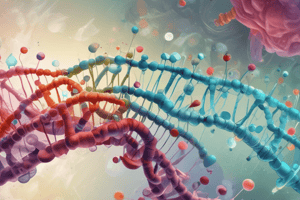Podcast
Questions and Answers
What are the two most common core promoters in protein-encoding genes?
What are the two most common core promoters in protein-encoding genes?
The TATA box and the Inr (Initiator) element
What is the role of chromatin-remodeling complexes in eukaryotic transcription?
What is the role of chromatin-remodeling complexes in eukaryotic transcription?
To alleviate repression due to nucleosomes by mediating ATP-dependent conformational changes in nucleosome structure
What is the function of the Mediator complex in transcription initiation?
What is the function of the Mediator complex in transcription initiation?
To allow RNA polymerase II to communicate with transcriptional activators bound at sites distant from the promoter
What are the two sets of factors that are important for activation of eukaryotic transcription?
What are the two sets of factors that are important for activation of eukaryotic transcription?
What is the role of general transcription factors in the assembly of the preinitiation complex (PIC)?
What is the role of general transcription factors in the assembly of the preinitiation complex (PIC)?
What is the primary difference between the three classes of RNA polymerases in eukaryotes?
What is the primary difference between the three classes of RNA polymerases in eukaryotes?
What is the significance of α-amanitin in the study of eukaryotic transcription?
What is the significance of α-amanitin in the study of eukaryotic transcription?
How do the subunits of RNA polymerases in eukaryotes compare to those in prokaryotes?
How do the subunits of RNA polymerases in eukaryotes compare to those in prokaryotes?
What is the functional significance of the large size of RNA polymerases in eukaryotes?
What is the functional significance of the large size of RNA polymerases in eukaryotes?
How do the three classes of RNA polymerases in eukaryotes relate to each other evolutionarily?
How do the three classes of RNA polymerases in eukaryotes relate to each other evolutionarily?
What is the role of leader peptides in transcription attenuation, and how does this mechanism regulate gene expression in prokaryotes?
What is the role of leader peptides in transcription attenuation, and how does this mechanism regulate gene expression in prokaryotes?
How do operons regulate gene expression in prokaryotes, and what are the advantages of this type of regulation?
How do operons regulate gene expression in prokaryotes, and what are the advantages of this type of regulation?
What is the role of amino acid biosynthesis in the regulation of gene expression, and how do feedback inhibition and repression mechanisms contribute to this regulation?
What is the role of amino acid biosynthesis in the regulation of gene expression, and how do feedback inhibition and repression mechanisms contribute to this regulation?
What is post-transcriptional regulation, and how do mechanisms such as RNA splicing, editing, and degradation regulate gene expression?
What is post-transcriptional regulation, and how do mechanisms such as RNA splicing, editing, and degradation regulate gene expression?
How do chromatin remodeling complexes regulate gene expression in eukaryotes, and what is the significance of this regulation?
How do chromatin remodeling complexes regulate gene expression in eukaryotes, and what is the significance of this regulation?
What is the primary difference between transcription and translation in prokaryotes and eukaryotes?
What is the primary difference between transcription and translation in prokaryotes and eukaryotes?
What is the purpose of transcript processing in eukaryotes?
What is the purpose of transcript processing in eukaryotes?
What is the significance of the fact that eukaryotic mRNAs are monocistronic?
What is the significance of the fact that eukaryotic mRNAs are monocistronic?
What is the function of introns in eukaryotic genes?
What is the function of introns in eukaryotic genes?
What is the complexity of the mechanism by which introns are excised and exons are spliced together?
What is the complexity of the mechanism by which introns are excised and exons are spliced together?
Flashcards are hidden until you start studying




